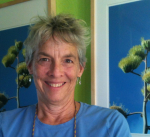Sensei Akihiko Izukura
 Saturday, February 24, 2007 at 01:42PM
Saturday, February 24, 2007 at 01:42PM 
I went to church today, although it was Saturday, and the chapel was a gallery lined with chairs. The spiritual master who presented his message was textile sensei Akihiko Izukura, and, although he spoke in Japanese through a translator, the message of his personal presence was clear in any language. Izukura, born into a traditional obi-making family business, has welded tradition, history and innovation into his factories, his dye ceremonies (more on that after I participate tomorrow) and his garments that manage to be both ethereal and earthy.

His dye baths are used until the pigment is all transfered to the cloth; the dye materials are burned and their ashes incorporated into handmade paper and glazes for pottery. People in his workplace are as carefully matched, and he refuses to go to cheaper labor markets for his handmade clothing, keeping work in the rural communities of Japan where women sit at looms to weave the silk garments -- the garments themselves designed much as sweaters are, without cutting and waste of fabric.

At the heart of his work is the idea of "not choosing."
"Using natural materials is using and borrowing their lives to make something new. All is appreciated. All the stages, all the the parts. This is the basic thought: not choosing, not one thing over another as more beautiful. To appreciate all of the lives. This is what I call the aesthetics of consideration."
I don't know how I can incorporate more of his zero waste philosophy into my own work -- in a way, my insistence on using thrift store fabrics and old clothing as the raw material for most of my work -- is my own version of that philosophy, if not as stringent and well conceived. I also like to use my dye liquids as much as I can -- throwing fabric into "exhausted" dye pots, to achieve background tints, if nothing else. Yes, I use commercial chemical dyes and probably too much of them. Today's lecture does inspire me to look more closely -- and yes, to get back to the recycling I gave up when it started seeming too hard to do from 30 miles north of the city limits. (I'll add photos of the exhibit and of Izukura when I get home and can download the pictures, so check back if they aren't here yet.)

The Southwest School of Art and Craft website says this about Izukura's philosophy and practise:
Through his nearly spiritual engagement with textile processes, Akihiko Izukura imbues his garments and artwork with beauty and a sense of peace. As one of Japan's most extraordinary textile artists, Izukura’s personal philosophy of natural harmony has led to an extraordinary zero-waste philosophy. For instance, he works mainly in silk, and every part of the silk cocoon – even parts considered waste – is used in the weaving. Garments are designed and engineered as they are woven, eliminating the need to cut into the fabric, which would leave waste.
Izukura has pioneered a way of dyeing that doesn't pollute water. He uses only natural materials (nuts, betel palm, onionskin and so on) for colors, and then uses every drop of the dye liquid, so that color intensity changes from piece to piece. In fact, even the materials used to extract the dye are processed into a powdery ash that is then used for pottery glazes or papermaking.
Read more about Akihiko Izukura at his website, http://www.akihikoizukura.com/en/.






Reader Comments